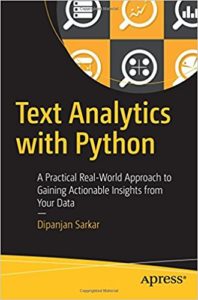 This is a book review of Text Analytics with Python: A Practical Real-World Approach to Gaining Actionable Insights from your Data by Dipanjan Sarkar
This is a book review of Text Analytics with Python: A Practical Real-World Approach to Gaining Actionable Insights from your Data by Dipanjan Sarkar
One of my go-to books for natural language processing with Python has been Natural Language Processing with Python: Analyzing Text with the Natural Language Toolkit by Steven Bird, Ewan Klein, and Edward Loper. This has been the book for me and was one of my dissertation references. I used this book so much, that I I had to buy a second copy of this book because I wore the first one out. I’ve read many other NLP books but haven’t found any that could match this book – till now.
Text Analytics with Python: A Practical Real-World Approach to Gaining Actionable Insights from your Data by Dipanjan Sarkar is a fantastic book and has now taken a permanent place on my bookshelf.
Unlike many books that I run across, this book spends plenty of time talking about the theory behind things rather than just doing some hand-waving and then showing some code. In fact, there isn’t any code (that I saw) until page 41. That’s impressive these days. Here’s a quick overview of the book’s layout:
- Chapter 1 provides the baseline for Natural Language. This is a very good overview for anyone that’s never worked much with NLP.
- Chapter 2 is a python ‘refresher’. If you don’t know python at all but know some other language, this should get you started enough to use the rest of the book.
- Chapter’s 3 – 7 is there the real fun begins. These chapters cover Text Classification, Summarization Similarity / Clustering and Semantic / Sentiment Analysis.
If you have some familiarity with python and NLP, you can jump to Chapter 3 and dive into the details.
What I really like about this book is that it places theory first. I’m a big fan of ‘learning by doing’ but I think before you can ‘do’ you need to know ‘why’ you are doing what you are doing. The code in the book is really well done as well and uses the NLTK, Sklearn and gensim libraries for most of the work. Additionally, there are multiple ‘build your own’ sections where the author provides a very good overview (and walk-through) of what it takes to build your own functionality for your own NLP work.
This book is highly recommended.
Links in this post:
Natural Language Processing with Python: Analyzing Text with the Natural Language Toolkit by Steven Bird, Ewan Klein, and Edward Loper.
Text Analytics with Python: A Practical Real-World Approach to Gaining Actionable Insights from your Data by Dipanjan Sarkar
The post Text Analytics with Python – A book review appeared first on Python Data.